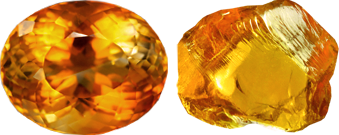 Photo of Citrine in Processed & Rough Form
Photo of Citrine in Processed & Rough Form
Citrine is a mineral with a hardness of 7 out of 10 on the Mohs scale of mineral hardness [?]. These Trigonally structured gems are made of silicon dioxide, their full chemical compound being SiO2.
Citrine is an attractive type of quartz, which is the commonest mineral on the earth's surface. But citrine itself is an uncommon macrocrystalline variety. Its yellow color brought about by its iron hydrate content, its reddish yellow from a trace of ferric iron. It forms hexagonal prisms, terminated by pyramidal shapes. Its faces are often striated, and the crystals twinned and distorted, having an uneven fracture at its base. It occurs in granular, stalactitic, and cryptocrystalline habits. It is a transparent to translucent mineral, and has a vitreous luster on fresh surfaces.
Natural citrines are mostly pale yellow. Treated citrines show no pleochroism (property of exhibiting different colors), while natural citrines have weak pleochroism.
It is insoluble, except in hydrofluoric acid.
Natural citrine is rare. The best comes from Brazil (Bahia, Goyez, Minas Gerais). There are also deposits in Madagascar, Pike's Peak, Colorado (USA), Spain (Cordoba, Salamanca), Russia (Mursinska/Ural), France, and Scotland. It also occurs as ametrine (part citrine, part amethyst) from the Anahi mine, Bolivia.
Five types of citrine coloration exist: orange-brown natural quartz containing iron; yellow to orange-brown colours produced by the heating of amethyst; yellow to orange-brown colours in synthetic quartz grown in the presence of iron; light yellow radiation-induced colour found naturally in quartz or produced by heating smoky quartz; greenish yellow colour produced by irradiation (with or without subsequent heat treatment) either of natural colorless quartz or synthetic colorless quartz.
Citrine may be confused with all yellow gemstones, especially yellow beryl, orthoclase, yellow topaz, and yellow tourmaline.
What is Citrine?
Citrine is yellow to golden-brown quartz, colored by iron. Most commercial citrine is heat-treated amethyst or smoky quartz. Natural citrine is relatively rare and typically paler than treated stones.
Where is it found?
Natural citrine is found in Brazil, Madagascar, Spain, and Russia. Most commercial citrine comes from Brazil, where amethyst is heat-treated to produce the golden color.
How can I identify natural Citrine?
Natural citrine has pale yellow to honey colors. Heat-treated stones often show reddish or orange tints. Natural pieces rarely show the deep orange-brown seen in treated stones.
What's its historical significance?
Named from French "citron" meaning lemon. Popular in Art Deco jewelry of the 1930s. Sometimes called "Merchant's Stone" as it's believed to bring prosperity and success.
Natural vs. Heat-Treated?
Over 95% of commercial citrine is heat-treated amethyst. Natural citrine typically has lighter, more subtle colors. Heat-treated stones often have orange-brown or reddish tints.
What determines its value?
Natural specimens command higher prices. Vivid yellow to golden colors are most valued. Large, clean stones with good clarity are rarer and more expensive. Treated stones are generally affordable.
The specific gravity [?] for Citrine is 2.65, its refractive index [?] is 1.54-1.55, and its double refraction [?] is 0.009.
History
Citrine derives its name from the French, meaning "lemon-yellow." The ancient Romans used it for beautiful jewelry and intaglio, also as an amulet to protect the wearer from a snake venom, reptile bites, and even evil thoughts, plagues, and epidemics. In the 17th century, both citrine and smoky quartz were called "cairngorm" after their source in the Cairngorm Mountains of Scotland, and Scottish weapon makers used citrine to adorn dagger handles, sometimes even using a single large citrine crystal as the handle itself. It was also very popular for jewelry in the 19th century.
Industrial Usages
Today, jewelers may advertise that citrine is no longer rare, but in fact, most commercial citrines are heat-treated amethysts or smoky quartz. Brazilian amethyst turns light-yellow to dark-yellow to red-brown, depending on heat temperature. Some smoky quartzes turn yellow at a lower temperature so care needs to be taken when soldering.
Quartz is used in glassmaking, ceramics, refractories, building materials, and abrasives. Its piezoelectronic property makes it useful in pressure-sensitve devices.
The mineral trade often calls citrines "topazes" but this is incorrect, and should not be allowed, even when qualified as Bahia-, gold-, Madeira-, Palmyra-, Rio Grande-topaz. Most of the citrines on offer in the trade have a tinge of reddish.
Synthetically-colored stones are now produced in Russia and Japan on a commercial scale.
Well-colored, transparent specimens are used are ring-stones and pendants, while less attractive stones are made into necklaces or ornaments.






